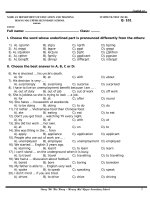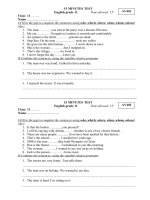15 Test Taking Strategies Every Test Taker Should Know
Bạn đang xem bản rút gọn của tài liệu. Xem và tải ngay bản đầy đủ của tài liệu tại đây (2.03 MB, 36 trang )
15 Test Taking Strategies Every Test
Taker Should Know
•Get plenty of rest
the night before
each testing day
You need 8-10
hours of sleep, so
go to bed by 10pm.
•Avoid the morning
rush. Set out clothes the
night before. Get to
school a few minutes
earlier than you usually
do.
•Eat a good nutritious
breakfast the
morning of each
testing day
(Milk w/cereal, eggs,
fruits; no Hot Cheetos
and candy.)
Can You Follow Directions?
Get Out a Sheet of Paper and
Take
This
Test.
N YU FLL
DRTN?
•T his is a t im ed t estou hav e m inut es onl!
• R ead ev ert hin g car efull befor e do in g ant hin g
• ut our n am e in t he upp er r ight han d corn er o f t his
ppr
• Loul ll out our rst nm
• ir cl e our n am e
• f ou hav e follow ed dir ect ions car efull to t his
po int ca
ll out " ha
v e”
• Dr aw fiv e sm all squ ar es in t he upp er l eft han d
ornr
• ut an "X" in each squ ar e
• n our norm al sp eai
gn i vo ce count from t en to on e
wrs
• Now t hat ou hav e fin is hed r eadin g ev ert hin g
rull o onl sntns on n two
Always listen to the
LISTEN directions given by teacher.
• Read the directions
written on the test.
READ
• Read the question
and ALL answer
ASK
choices before
marking anything.
2. It is important
1. Don’t spend
too much time
on any one
question.
5. Answer the
easiest
questions first,
but be sure to go
back to those
questions you
skipped.
to answer every
question even if
you are not sure
of the answer.
4. Save time at the
end to review
your test and
make sure you
haven't left out
any answers.
3. Use all your
time! There are no
extra points for
finishing early.
PACE YOURSELF
T sp ir e th an d t R eadi
n g Qu est ions inut es =
n v er age
o f L ess T ha
n inut es Qu est ion
T spr t at h Qu est ions inut es= n v er age
o f bout inut e an d ec
on ds er Qu est ion
T spr t at h Qu est ions inut es= n v er age
o out nut n ons r Quston
RR T D T H T RL FRT
N TN UR N K!
If you can’t figure out
which answer is correct,
try to eliminate (get rid
of) the answers that you
know are wrong.
Eliminate
obviously
wrong
answer
Eliminate choices
choices
that are partly
correct
Eliminate items that
are correct but don’t
answer the
question
A random guess gives
you a 25% chance
of getting the right
answer. An educated
guess gives you
chance of answering
correctly up to
75% .
Educated guessing
means using
everything you know
to attempt to answer
the question.
ANSWERS WITH THE
FOLLOWING WORDS
ARE USUALLY
WRONG/FALSE.
ALL
MUST
ALWAYS
NONE
NEVER EVERY
ENTIRELY BEST
WORST ONLY
EVERYONE
SOME
SOMETIMES
GENERALLY
USUALLY
FREQUENTLY
PROBABLY
MOST
FEW
MANY
OFTEN
SELDOM
ANSWERS WITH THE
FOLLOWING WORDS
ARE USUALLY
CORRECT/TRUE
WHEN THE ANSWER IS
NOT CLEAR, LOOK FOR
CLUES ( CONTEXT,
TENSE, WORD TYPE,
GRAMMAR) IN THE
QUESTION AND THE
ANSWER CHOICES
The context of a word
includes all the words and
sentences that surround it
and the situation in which
the word is used.
Clue words in test
questions:
Who? Person What?
Thing
Where? Place When?
Time Why? Reason
Which? Choice
How? A way something is
done
How many ? Number
Example
ur cl ass w ill s eea
pl a__________e
dn
hs t is
1.Use elimination
w ee
strategy first…
a
ho
2. Look for a clue
bt
3. Play is a noun
in this sentence,
c
so ask yourself
dn
what kind of a
play it is.
The effect of negatives is
to make the sentence the
opposite of what it would
be without the negative.
Negatives:
Not None No one
Hardly Scarcely
Prefixes such as
Un- Non- Dis- In-
Simplify the question by
getting rid of double
negatives.
Simplify this statement:
Most people are
not unafraid of snakes.
Most people are
afraid of snakes.
Example
rs m it h disl ie
s wn
stu de
nts ar e bei
n g ru deto
t hei
r t eache
rs
it hout cha
n gig
n t hem eai
n n g o f t he
s ent en ce
w hich
wor ds ca
n be
st beus ed
to rpl t unrln prt?
nos
Tolrts
un is he
s
DD
o es not l ie
In Math, ESTIMATING is an approximate answer
obtained by rounding the numbers BEFORE you
add, subtract, multiply, or divide.
Always ask yourself: “Is the
answer reasonable?”
What is 325+917+ 796?
A. 56 B. 2038 C. 1038 D. 10,564
Examples
hat v alu e o f N
m ae
hs t e equ at ion
tru?
N=
D
Eliminate
obviously
wrong
answers first
and then
estimate!
Example
An airplane flew 2905 miles in 5 hours.
What
speed
the h
plane?
was
m ithe
le
s pof
er
our
m il es p er hour
m il es p er hour
D m il es p er hour
1. Read all the titles, labels, and other given
information
2. Check the units of measurement
3. Look for a pattern, trend, or comparison in the
graph or table
1. Read the title of the map
2. Check the map key( legend)
3. Look at the map scale (if you
need to find a distance)
4. Re-read the question again
Other Math Tips
• Us e cr at ch ap er
• Dou bl e hec To ae
e ur e Youv
cop ied t he pro bl em corr ectl
• Ln Up l Vlus
(t hous an ds hun dr ed
s t ens
on es N ea
tl To vo id ar el ess
sts
• ace
Yours el f
V N ND
H K!
•Answers about where and when
the story takes place are found at
the beginning.
•Answers about a problem of the
story are usually found in the
middle.
•Answers about how the problem
was resolved are usually found at
the end.
When Reading a
Passage Remember To:
R D T H QUTN FRT
to de
t erm in e w ha
t ou
ar e loo in g for as ou
r ead
t hes el ec
t ion
What’s the
Big Idea?
•Events and characters
that make up the story
•The purpose of the
story
•The point the author is
trying to make
Tip: Look for the Big
idea in the first two
paragraphs of the
story!









